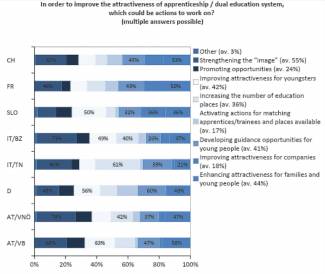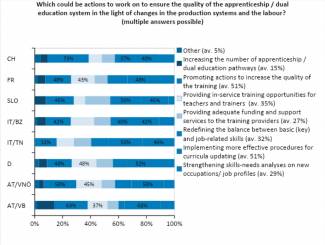Image et valeur de la formation en alternance
Une faible image publique de la formation en alternance en général et en particulier de l’artisanat plane sur les régions de l’espace alpin.
Dans plusieurs pays, on observe une augmentation de l’académisation, soutenue indirectement par les enseignants et les parents qui encouragent les jeunes à viser l’enseignement supérieur. L’enseignement de troisième niveau et les diplômes universitaires sont considérés comme la garantie d’un emploi sûr et bien rémunéré ainsi que de multiples possibilités de carrière. En outre, il y a une faible réputation publique de certaines professions respectivement des industries commerciales.

Visibility
As manager or in-company-trainer of a training-company, you should emphasize the value of the training in your company by improved public as well as medial visibility. Thus, aim to promote the features of your enterprise and various benefits of an apprenticeship at your place (e.g., specialization in certain skills, networks, sustainability), talk about career success stories of employees (e.g., at schools, job fairs, homepage, social media) and provide open house days for potential future apprentices at your company, at which they could watch and maybe also try out work processes.
Awareness rising
Beside the recommendations above, potential apprentices and future employees would also benefit from direct confrontation with the fruits of your company. Thus, give floor to people trained in your company, let themselves present their success stories and answer arising questions at events like school visits, job fairs or open house days. Such events also give opportunity to promote your work and its meaning, for example products made for elderly’s support in everyday life.
The participation in apprenticeship competitions is another possibility to enhance the visibility and value of your training-company.
Quality enhancement
To contribute to the enhancement of the quality of dual education and training, training-companies should improve the cooperation with vocational schools as well as schools in general. Within a joint redefinition of education and training objectives, the demands of the labour market as well as companies (e.g. balance between basic and job-related skills) have to be considered to prepare apprentices for their future work.
Moreover, further specific training and coaching for in-company-trainers and teachers could support them in reacting to apprentices with special needs due to their, e.g., age, language, cultural or educational background.
Furthermore, the improvement of mobility programs for apprentices and the development of mobile programs for trainees in adult age as well as skilled workers can significantly contribute to the enhancement of the quality of dual education and training, as your company and employees can benefit from experiences in other enterprises and vice versa.
Key results from the SME needs assessment within DuALPlus
In spite of their different dual education systems, the partner regions partly struggle with similar challenges, which give insights in SMEs’ needs in the Alpine Space. While representatives of companies emphasized the link of theoretical and practical learning, the possibility of an earlier entry in the labour market as well as of gaining work experiences and sense of responsibility at a younger age as positive aspects respectively strengths of dual education, they also referred to several critical issues and weaknesses. In the following, the key results are presented from a transnational point of view.
1. Data on image and the value of apprenticeships
In the questionnaires as well as in the expert interviews image problems of dual education in the Alpine Space were frequently discussed. The value of particularly vocational training in crafts seems to be underestimated in the partners’ regions: parents and youngsters prefer higher educations. Considering this issue, the SMEs’ representatives were asked which could be actions to work on to improve the attractiveness of dual education.
The priority actions are similar in the partner’s regions. The strengthening of the image respectively value of dual education (average 55%) goes hand in hand with enhancing the attractiveness of dual education for families and young people (average 44%) as well as improving the attractiveness for the youngsters (average 42%) in particular. The participants made a few suggestions for possible actions to increase the attractively of dual education, such as the enabling of possibilities of vocal training in combination with higher education (e.g. high school diploma), higher promotion of job information events and fairs, web portals for dual education formats or vocational orientation (e.g. as school subject) in schools (level 1 respectively 2). Furthermore, it could be promising to work on the guidance for students in the transition between different school levels. Not at least, presentations of success stories as well as case studies of e.g. successful craftswomen or craftsmen could lead to a more positive image of dual education.
Increasing the number of education places is central mainly in the autonomous province Trento (61%), Vorarlberg (42%) as well as in Vienna and Lower Austria (42%). The development of guidance opportunities for young people is an issue especially in Bavaria (60%), France (44%) and Switzerland (43%). Promoting opportunities for dual education is central in particular in Vorarlberg (37%), Bavaria (32%) and Vienna respectively Lower Austria (32%).
Improving the attractiveness for companies to train young people is an issue primarly in Switzerland (37%), Slovenia (36%) and France (28%). Respondents suggested offering SMEs more financial incentives for proposing themselves as training companies.
The following table give an overview of recommended actions to improve the attractiveness of apprenticeship from a transnational perspective in Alpine Space we investigated within the SME needs assessment analysis.

Source: Lime Survey, own computation. AT/VB = Austria/Vorarlberg, AT/VNÖ = Austria/Vienna-Lower Austria; D = Germany/Bavaria, IT/TN = Italy/Trento, IT/BZ = Italy/Bolzano, SLO = Slovenia, FR = France, CH = Switzerland.
2. Data on the quality of the dual education systems
Another issue of the data gathering was the guarantee of dual education and training. To ensure the quality of the dual education system, especially in light of the changes in the production systems and the labour markets, the respondents of the partners’ regions mentioned certain actions to work on.
The priority actions are similar in the partners’ regions. So, the promotion of actions to increase the quality of the training (average 51%) as well as the implementation of more effective procedures for curricula updating (average 51%) are especially relevant in all partners’ regions. Other often mentioned needed actions were providing in-service training opportunities for teachers and trainers (average 35%) as well as redefining the balance between basic (key) and job-related skills (average 32%).
Strengthening skills-needs analyses on new occupations respectively job profiles is central mainly in Trento (46%), Bavaria (40%) and France (39%). Providing adequate funding and support services to the training providers is an issue primarily in Slovenia (41%), Bavaria (32%) and Bolzano (28%). Increasing the number of dual education pathways is central especially in Vorarlberg (32%), Slovenia (18%) and Bavaria (16%).
Other measures included higher financial support of training companies, stronger promotion of training in the regions, revision of school curricula with regard to SMEs’ needs as well as the strengthening of handcraft trades.
The following table gives an overview of recommended actions to ensure the apprenticeship in light of the changes in the production systems and the labour from a transnational perspective in Alpine Space we investigated within the SME needs assessment analysis.

Source: Lime Survey, own computation. AT/VB = Austria/Vorarlberg, AT/VNÖ = Austria/Vienna-Lower Austria; D = Germany/Bavaria, IT/TN = Italy/Trento, IT/BZ = Italy/Bolzano, SLO = Slovenia, FR = France, CH = Switzerland.
3. Data on the improvement of the dual education procedure
To get a full picture of the evaluation and demands of SMEs in the Alpine Space, it was important to take into account issues about the dual education procedure as well as of the cooperation between companies, schools and trainees.
On the average, 60% of the respondents are involved in the final assessment of their trainees, 47% participate in trilateral meetings between companies, schools as well as trainees and 45% are involved in the development of individual training plans

